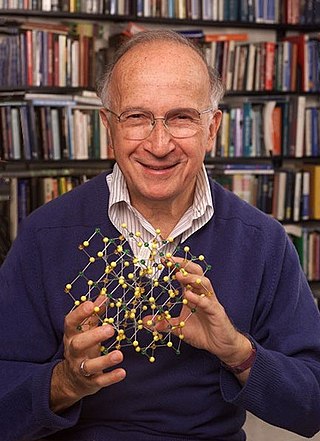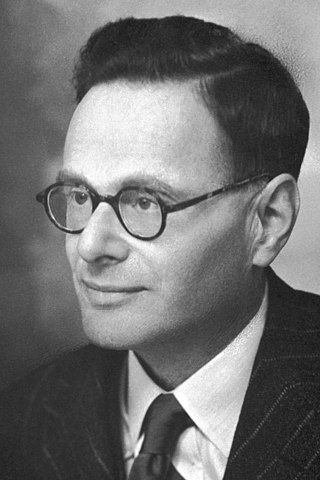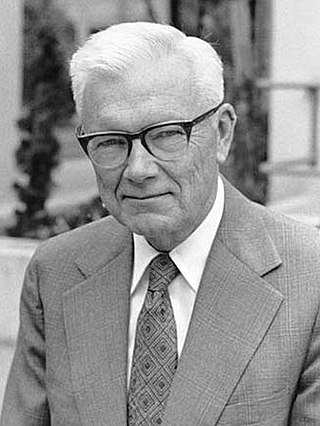Related Research Articles

Roald Hoffmann is a Polish-American theoretical chemist who won the 1981 Nobel Prize in Chemistry. He has also published plays and poetry. He is the Frank H. T. Rhodes Professor of Humane Letters, emeritus, at Cornell University, in Ithaca, New York.

Carl Peter Henrik Dam was a Danish biochemist and physiologist.

Sir Hans Adolf Krebs, FRS was a German-British biologist, physician and biochemist. He was a pioneer scientist in the study of cellular respiration, a biochemical process in living cells that extracts energy from food and oxygen and makes it available to drive the processes of life. He is best known for his discoveries of two important sequences of chemical reactions that take place in the cells of nearly all organisms, including humans, other than anaerobic microorganisms, namely the citric acid cycle and the urea cycle. The former, often eponymously known as the "Krebs cycle", is the sequence of metabolic reactions that allows cells of oxygen-respiring organisms to obtain far more ATP from the food they consume than anaerobic processes such as glycolysis can supply; and its discovery earned Krebs a Nobel Prize in Physiology or Medicine in 1953. With Hans Kornberg, he also discovered the glyoxylate cycle, a slight variation of the citric acid cycle found in plants, bacteria, protists, and fungi.

Paul Delos Boyer was an American biochemist, analytical chemist, and a professor of chemistry at University of California Los Angeles (UCLA). He shared the 1997 Nobel Prize in Chemistry for research on the "enzymatic mechanism underlying the biosynthesis of adenosine triphosphate (ATP)" with John E. Walker, making Boyer the first Utah-born Nobel laureate; the remainder of the Prize in that year was awarded to Danish chemist Jens Christian Skou for his discovery of the Na+/K+-ATPase.

Carl Djerassi was an Austrian-born Bulgarian-American pharmaceutical chemist, novelist, playwright and co-founder of Djerassi Resident Artists Program with Diane Wood Middlebrook. He is best known for his contribution to the development of oral contraceptive pills, nicknamed the "father of the pill".

Kenichi Fukui was a Japanese chemist, known as the first person of East Asian ancestry to be awarded the Nobel Prize in Chemistry.

Paul Berg was an American biochemist and professor at Stanford University.

Henry Taube, was a Canadian-born American chemist who was awarded the 1983 Nobel Prize in Chemistry for "his work in the mechanisms of electron-transfer reactions, especially in metal complexes." He was the second Canadian-born chemist to win the Nobel Prize, and remains the only Saskatchewanian-born Nobel laureate. Taube completed his undergraduate and master's degrees at the University of Saskatchewan, and his PhD from the University of California, Berkeley. After finishing graduate school, Taube worked at Cornell University, the University of Chicago and Stanford University.

Arthur Kornberg was an American biochemist who won the Nobel Prize in Physiology or Medicine 1959 for the discovery of "the mechanisms in the biological synthesis of ribonucleic acid and deoxyribonucleic acid" together with Spanish biochemist and physician Severo Ochoa of New York University. He was also awarded the Paul-Lewis Award in Enzyme Chemistry from the American Chemical Society in 1951, an L.H.D. degree from Yeshiva University in 1962, and the National Medal of Science in 1979. In 1991, Kornberg received the Golden Plate Award of the American Academy of Achievement and the Gairdner Foundation Award in 1995.

Paul John Flory was an American chemist and Nobel laureate who was known for his work in the field of polymers, or macromolecules. He was a leading pioneer in understanding the behavior of polymers in solution, and won the Nobel Prize in Chemistry in 1974 "for his fundamental achievements, both theoretical and experimental, in the physical chemistry of macromolecules".

Luis Ernesto Miramontes Cárdenas was a Mexican chemist known as co-inventor and the first to synthesize an oral contraceptive, progestin norethisterone.

Roger David Kornberg is an American biochemist and professor of structural biology at Stanford University School of Medicine. Kornberg was awarded the Nobel Prize in Chemistry in 2006 for his studies of the process by which genetic information from DNA is copied to RNA, "the molecular basis of eukaryotic transcription."

Mildred Cohn was an American biochemist who furthered understanding of biochemical processes through her study of chemical reactions within animal cells. She was a pioneer in the use of nuclear magnetic resonance for studying enzyme reactions, particularly reactions of adenosine triphosphate (ATP).

The Nobel Prize in Chemistry is awarded annually by the Royal Swedish Academy of Sciences to scientists in the various fields of chemistry. It is one of the five Nobel Prizes established by the will of Alfred Nobel in 1895, awarded for outstanding contributions in chemistry, physics, literature, peace, and physiology or medicine. This award is administered by the Nobel Foundation, and awarded by the Royal Swedish Academy of Sciences on proposal of the Nobel Committee for Chemistry which consists of five members elected by the Academy. The award is presented in Stockholm at an annual ceremony on 10 December, the anniversary of Nobel's death.

The American Institute of Chemists Gold Medal is the highest award of the American Institute of Chemists and has been awarded since 1926.
The Lichtenberg Medal is the highest award of the Göttingen Academy of Sciences and Humanities. It was established in memory of the Göttingen scholar Georg Christoph Lichtenberg. It has been awarded since 2004 to "outstanding scientists who are respected by the public". The winner receives a gold medal and a certificate.
Isabella Gregor is an Austrian actress and theatre director.
References
- ↑ Robert C. Roach, Peter D. Wagner, Peter H. Hackett Hypoxia: Through the Lifecycle 1441989978- Page 16
- ↑ Hoffmann, Roald. "Schedule". Roald Hoffmann. Retrieved 19 March 2023.
OXYGEN A new play, 'Oxygen' was authored by Roald Hoffman, Professor of Chemistry at Cornell who received the chemistry Nobel prize in 1982, and Carl Djerassi, the Stanford biochemist and writer who popularized the pill for ...
- ↑ Shepherd-Barr, Kirsten (2006). "'Just a Fiction': Staging History and Truth". Science on Stage: From Doctor Faustus to Copenhagen. Princeton University Press. pp. 182–98. ISBN 978-0691155449. JSTOR j.ctv2tvzq2.12 . Retrieved 19 March 2023.
This group of plays are all part of Djerassi's self-described "science-in-theater," which he has explained as having substantial ... For example, in Oxygen, he and Roald Hoffmann dramatize the events leading to the discovery of oxygen in the...